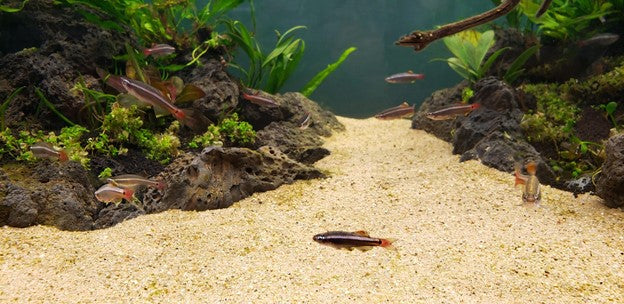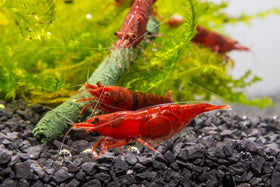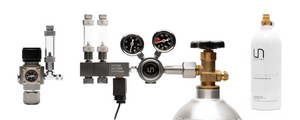
Tips for Maintaining an Aquascape with Multiple Substrates
Written by: Tammy (@aquarist_tl) and Team Buce Plant
Many classic nature aquascapes these days use multiple types of substrates in their layouts. The two most prominent ones are usually sand and soil. Sand is commonly used in the foreground of the scape to give it a nice clean look while aquarium soil is typically found in the middle and back areas of the tank to provide nutrients for the aquatic plants when they are added. There are even extravagant aquascapes that will use the sand to form paths or “rivers” within the aquarium.
Although the use of multiple substrates can greatly add to the beauty of an aquascape, it can sometimes be a hassle to maintain. When the soil rolls or falls into areas where there should only be sand, it can be unsightly.
Here are some tips for those of you interested in building an aquascape that uses multiple substrates and for those that are already maintaining them.
1. Add Barriers
After thinking about where you want to place the sand and soil respectively, it’s best to add barriers between them to keep the substrates from getting mixed. In a typical nature themed aquascape, scapers will align large pieces of aquarium rocks and stones to create a barricade around the soil. This should contain most of the aquasoil within its designated areas, thoroughly keeping the substrates separate from one another.

Icelandic Lava Stone holding the Tropica Aquarium Soil in place
A common design for aquascapes is to have the aquarium soil be higher in the back and then gradually lower towards the front of the tank. This layout creates a sense of depth within the aquarium. A great way to keep some of the aquasoil from rolling down these hills is to strategically place rocks along them. This should help maintain the steepness of the soil and help hold the formation of the man-made mountains more than if it were bare.
2. Fill the Cracks
While barriers are able to keep most of the substrates from mixing with one another, a common way for some of the substrates to meet is through the cracks of the barricades. It can be difficult to align the rocks in such a way that there are absolutely no cracks or holes for substrate to fall through.
One way to resolve this issue is to use an item like filter floss to close the gaps between the rocks. Filter floss is often used as mechanical filtration in the aquarium hobby, so it is safe to put inside the tank. Professional scapers tend to use it before adding the actual substrate in. They first build the barricade of rocks, and then stuff the cracks with filter floss from behind so that it is not visible through the front of the tank. Sometimes, even the smallest of cracks can pose a problem. It can be hard to jam filter floss in cracks that are extremely narrow. In these situations, I like to use an old credit card or gift card to help push the filter floss through these skinny gaps.

You can spot some filter floss peeking through the crack between the two pieces of Seiryu stone above the corydoras similis.
Another way to close the holes within the aquascape is to use pond or waterfall foam sealants. They are designed to help fill in gaps that are obstructing the flow in waterfalls for ponds. The foam is usually black, so it should work well with darker colored stones like Black Mountain Seiryu Stone or Black Lava Rock.
3. Plant Heavily
Aquatic plants play a key role in keeping aquarium soil in place. Similar to how trees and plants prevent mudslides and erosion, aquarium plants will do the same for our man-made mountains. Their roots will sink deep into the soil, anchoring in place most of the aquasoil that is underneath the plant. Foreground plants are probably the best for this specific job. Carpeting plants propagate and spread quite quickly to cover most of the surface area, growing over the soil and locking everything in place.

Monte Carlo adjusting to its new aquarium
A quick and easy method you can use is to cover some patches with moss fastened onto stainless steel. This should be able to prevent the substrate sitting under it from moving. Moss, as well as epiphyte plants, are great choices for filling in gaps that the substrate could fall through. They would serve the purpose of preventing the substrates from mixing while also making the aquarium look more natural!
4. Thoughtfully Choose Your Livestock
The inhabitants of the aquarium play a large part in whether you will do more work or less to maintain the division of substrates. If you want to do less work, a general rule to follow is: the smaller the species, the better. Small fish have less of an impact because they’re too small to fit any soil in their mouths and aren’t usually strong enough to move the soil out of place. An excellent livestock choice with this goal in mind are shrimp! Since they’re so tiny, they are highly unlikely to disturb the substrate. If any of the shrimp could, it’d probably be the Amano shrimp. I’ve seen large ones actually pick up pellets off the ground and carry them into other parts of the tank!

Corydoras are great peaceful fish, but can add more maintenance for tanks with sand and soil
Fish to avoid in tanks with multiple substrates are large fish that like to dig or pick through the substrate. Examples of fish that are notorious for picking up sand or gravel into their mouths and spitting them back up are goldfish and geophagus. They could definitely blend your substrates up to a point of no return. Other fish you may want to be careful with are bottom dwellers like plecos, loaches, and corydoras. They will glide against the soil and can push pieces onto areas that should contain only sand. This can also happen when they are digging through the substrate looking for food.
Extra Tips for Cleaning Sand
Even when you take many precautions to try and prevent soil from tumbling onto sand, it can unfortunately still end up happening.
One method you can use to clear pieces of soil off the sand is to siphon it out. Airline tubing can be used if the soil pieces are small enough, otherwise you may use vinyl tubing with a larger diameter to hover over the unwanted soil and suck them out of the aquarium.
Another trick you could do is to use a small sieve that let’s the fine sand particles fall through, but not the larger bits of soil. This way, you can sift the sand and toss the pieces of soil you collect back into the areas of the tank they should be in.
Lastly, if you have bits of soil here and there that you want to remove, you can try using a magnet. The magnet is able to magnetize the soil particles onto it (due to iron being in most aquarium soil products), making the collection of them quick and easy.

After spending so much time cleaning soil off sand, these are the tips and tricks I’ve picked up over the years. May they help you on your aquascaping journey!
Tell us - Was this article helpful? Comment your thoughts!
If you have any questions regarding this article, please DM us on Instagram or Facebook so we can assist you! @buceplant





Comments
Leave a comment